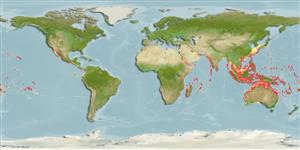Bivalvia |
Pectinida |
Pectinidae
Environment: milieu / climate zone / depth range / distribution range
Ecology
Benthic; depth range 0 - 100 m (Ref. 348), usually 0 - 5 m (Ref. 348). Tropical
Indo-Pacific: from East Africa, to eastern Polynesia; north to Japan and south to Queensland and New Caledonia.
Length at first maturity / Size / Weight / Age
Maturity: Lm ? range ? - ? cm Max length : 11.0 cm SHL male/unsexed; (Ref. 348); common length : 8.5 cm male/unsexed; (Ref. 348)
Maximum depth from Ref. 101147. Attached by its byssus to coral slabs, rubble under the slab (Ref. 101147), under coral heads and rocks (Ref. 348). Frequently encrusted by sponges, bryozoans, algae, and other marine growths. Able to swim actively for some distance when detached. Common in the intertidal and shallow subtidal zones (Ref. 348). Also occurs on rubble, soft sediments, and scattered reefs (Ref. 87907). At night, adults seem to move to open water to feed and return to rubble pile in the day (Ref. 101147).
Life cycle and mating behavior
Maturity | Reproduction | Spawning | Eggs | Fecundity | Larvae
Members of the class Bivalvia are mostly gonochoric, some are protandric hermaphrodites. Life cycle: Embryos develop into free-swimming trocophore larvae, succeeded by the bivalve veliger, resembling a miniature clam.
Poutiers, J.M. 1998 Bivalves. Acephala, Lamellibranchia, Pelecypoda. p. 123-362. In Carpenter, K. E. and V. H. Niem. 1998. FAO species identification guide for fishery purposes. The living marine resources of the Western Central Pacific. Volume 1. Seaweeds, corals, bivalves, and gastropods. Rome, FAO. (Ref. 348)
IUCN Red List Status
(Ref. 130435: Version 2025-1)
CITES status (Ref. 108899)
Not Evaluated
Not Evaluated
Threat to humans
Harmless
Human uses
| FishSource |
Tools
More information
Trophic EcologyFood items (preys)
Diet composition
Food consumption
Predators
Population dynamicsGrowth
Max. ages / sizes
Length-weight rel.
Length-length rel.
Length-frequencies
Mass conversion
Abundance
Life cycleReproductionMaturityFecunditySpawningEggsEgg developmentLarvae PhysiologyOxygen consumption
Human RelatedStamps, coins, misc.
Internet sources
Estimates based on models
Preferred temperature
(Ref.
115969): 24.6 - 29.2, mean 28.3 (based on 3624 cells).
Fishing Vulnerability
Low vulnerability (10 of 100).
